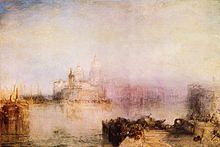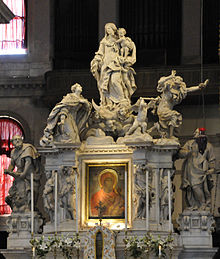- Santa Maria della Salute
-
Basilica of St Mary of Health
Basilica di Santa Maria della SaluteBasic information Location Venice, Italy Geographic coordinates 45°25′51″N 12°20′04″E / 45.43083°N 12.33444°ECoordinates: 45°25′51″N 12°20′04″E / 45.43083°N 12.33444°E Affiliation Roman Catholic Year consecrated 1681 Status Active Architectural description Architect(s) Baldassare Longhena Architectural type Church Architectural style Baroque Groundbreaking 1631 Completed 1687 Specifications Length 70 metres (230 ft) Width 47 metres (154 ft) Materials Istrian stone, marmorino The Basilica of St Mary of Health (Italian: Basilica di Santa Maria della Salute), commonly known simply as the Salute, is a Roman Catholic church and minor basilica located in the Dorsoduro sestiere of the Italian city of Venice. It stands on a narrow finger of land between the Grand Canal and the Bacino di San Marco making the church visible when entering the Piazza San Marco from the water. The Salute is part of the parish of the Gesuati and is the most recent of the so-called Plague-churches.
In 1630 Venice experienced an unusually devastating outbreak of the plague. As a votive offering for the city's deliverance from the pestilence, the Republic of Venice vowed to build and dedicate a church to Our Lady of Health (or of Deliverance, Italian: Salute). The church was designed in the then fashionable baroque style by Baldassare Longhena, who studied under the architect Vincenzo Scamozzi. Construction began in 1631. Most of the objects of art housed in the church bear references to the Black Death.
The dome of the Salute was an important addition to the Venice skyline and soon became emblematic of the city, inspiring artists like Canaletto, J. M. W. Turner, John Singer Sargent and Francesco Guardi.
Contents
History
Beginning in the summer of 1629, a wave of the plague assaulted Venice, and over the next two years killed nearly a third of the population. In the city 46,000 people died whilst in the lagoons the number was far higher, some 94,000.[1] Repeated displays of the sacrament, as well as prayers and processions to churches dedicated to San Rocco and San Lorenzo Giustiniani had failed to stem the epidemic. Echoing the architectural response to a prior assault of the plague (1575–76), when Palladio was asked to design the Redentore church, the Venetian Senate on October 22, 1630, decreed that a new church would be built.[1] It was not to be dedicated to a mere "plague" or patron saint, but to the Virgin Mary, who for many reasons was thought to be a protector of the Republic.[2]
It was also decided that the Senate would visit the church each year. On November 21 the Feast of the Presentation of the Virgin, in a celebration known as the Festa della Madonna della Salute, the city's officials parade from San Marco to the Salute for a service in gratitude for deliverance from the plague. This involved crossing the Grand Canal on a specially constructed pontoon bridge and is still a major event in Venice.
The desire to create a suitable monument at a place that allows for easy processional access from Piazza San Marco led senators to select the present site from among eight potential locations. The location was chosen partially due to its relationship to San Giorgio, San Marco and Il Redentore, with which it forms an arc. The Salute, emblematic of the city's piety, stands adjacent to the rusticated single story customs house or Dogana da Mar, the emblem of its maritime commerce, and near the civic center of the city. A dispute with the patriarch, owner of the church and seminary at the site, was resolved, and razing of some of the buildings began by 1631. Likely, the diplomat Paolo Sarpi and Doge Nicolo Contarini shared the intent to link the church to an order less closely associated with the patriarchate, and ultimately the Somascan Fathers, an order founded near Bergamo by a Venetian nobleman Jerome Emiliani, were invited to administer the church.[citation needed]
A competition was held to design the building. Of the eleven submissions (including designs by Alessandro Varotari, Matteo Ignoli, and Berteo Belli), only two were chosen for the final round. The architect Baldassare Longhena was selected to design the new church. It was finally completed in 1681, the year before Longhena's death. The other design to make it to the final round was by Antonio Smeraldi (il Fracao) and Zambattista Rubertini. Of the proposals still extant, Belli's and Smeraldi's original plans were conventional counter-reformation linear churches, resembling Palladio's Redentore and San Giorgio Maggiore, while Varotari's was a sketchy geometrical abstraction. Longhena's proposal was a concrete architectural plan, detailing the structure and costs. He wrote:
I have created a church in the form of a rotunda, a work of new invention, not built in Venice, a work very worthy and desired by many. This church, having the mystery of its dedication, being dedicated to the Blessed Virgin, made me think, with what little talent God has bestowed upon me of building the church in the ... shape of a crown.
Later in a memorandum, he wrote:
Firstly, it is a virgin work, never before seen, curious, worthy and beautiful, made in the form of a round monument that has never been seen, nor ever before invented, neither altogether, nor in part, in other churches in this most serene city, just as my competitor (il Fracao) has done for his own advantage, being poor in invention.
The Salute, while novel in many ways, still shows the influence of Palladian classicism and the domes of Venice. The Venetian Senate voted 66 in favor, 29 against with 2 abstentions to authorize the designs of the 26 year old Longhena. While Longhena saw the structure as crown-like, the decorative circular building makes it seem more like a reliquary, a ciborium, and embroidered inverted chalice that shelters the city's piety.[citation needed]
Exterior
The Salute is a vast, octagonal building with two domes and a pair of picturesque bell-towers at the back. Built on a platform made of 100,000 wooden piles, it is constructed of Istrian stone and marmorino (brick covered with marble dust). At the apex of the pediment stands a statue of the Virgin Mary who presides over the church which was erected in her honour. The façade is decorated with figures of Saint George, Saint Theodore, the Evangelists, the Prophets, Judith with the head of Holofernes.[1]
Interior
While its external decoration and location capture the eye, the internal design itself is quite remarkable. The octagonal church, while ringed by a classic vocabulary, hearkens to Byzantine designs such as the Basilica of San Vitale. The interior has its architectural elements demarcated by the coloration of the material, and the central nave with its ring of saints atop a balustrade is a novel design. It is full of Marian symbolism – the great dome represents her crown, the cavernous interior her womb, the eight sides the eight points on her symbolic star.
The interior is octagonal with eight radiating chapels on the outer row. The three altars to the right of the main entrance are decorated with scenes from the life of the Virgin Mary, patroness of the church, by Luca Giordano: Presentation of Our Lady in the Temple", Assumption of Our Lady, Nativity of Our Lady.[1] The third altar to the left of the entrance hosts a painting by Titian titled The Descent of the Holy Ghost.
The Baroque high altar arrangement, designed by Longhena himself, shelters an iconic Byzantine Madonna and Child of the 12th or 13th century, known as Panagia Mesopantitissa in Greek[3] ("Madonna the mediator" or "Madonna the negotiator") and came from Candia in 1669 after the fall of the city to the Ottomans. The statuary group at the high altar, depicting the queen of heaven expelling the Plague(1670) was a theatrical Baroque masterpiece by the Flemish sculptor Josse de Corte. It originally held Alessandro Varotari's painting of the Virgin holding a church that the painter submitted with his architectural proposal.
Tintoretto contributed Marriage at Cana in the great sacristy, which includes a self-portrait. The most represented artist included in the church is Titian, who painted St. Mark Enthroned with Saints Cosmas, Damian, Sebastian and Roch, the altarpiece of the sacristy, as well as ceiling paintings of David and Goliath, Abraham and Isaac and Cain and Abel, and eight tondi of the Doctors of the Church and the Evangelists, all in the great sacristy, and Pentecost in the nave.
 Dogana and Santa Maria della Salute, J. M. W. Turner (1843)
Dogana and Santa Maria della Salute, J. M. W. Turner (1843)
Influence
The church had a large influence on contemporary architects immediately after its completion. The structures modelled after the church include the basilica on the Holy Mountain in Glogówko, built by the Polish-Italians Jerzy Catenazzi, Jan Catenazzi and Pompeo Ferrari between 1675-1728 according to original design by Baldassarre Longhena.[4] Another example is Katarina Church in Stockholm, by Jean de la Vallée, reconstructed in 1723 by Göran Josua Adelcrantz.
Serbian poet Laza Kostić wrote a poem about the church titled Santa Maria della Salute[5] in 1909.[6] It is considered to be the finest example of his love poems and elegies.[6]
See also
Notes
- ^ a b c d Allen, Grant (1898), Venice, London: G. Richards, pp. 104–107, ISBN 0665050895, http://www.archive.org/stream/venicegrantallen00allerich#page/104/mode/2up
- ^ Avery, Harold (February 1966). "Plague churches, monuments and memorials". Proc. R. Soc. Med. 59 (2): 110–116. PMC 1900794. PMID 5906745. http://www.pubmedcentral.nih.gov/articlerender.fcgi?tool=pmcentrez&artid=1900794.
- ^ Καθημερινή 7 μέρες Ο Κρητικός πόλεμος http://wwk.kathimerini.gr/kath/7days/1998/01/25011998.pdf page 10-12 in Greek
- ^ (English) "Sanctuary in Swieta Góra". www.filipini.gostyn.pl. http://www.filipini.gostyn.pl/english/english.php. Retrieved 2009-11-27.
- ^ Laza Kostić: Santa Maria della Salute (English translation)
- ^ a b Scribd: Laza Kostić: Autobiografija (Autobiography of Laza Kostić) (Serbian)
References
- Hopkins, Andrew (1997). "Plans and Planning for S. Maria della Salute, Venice". The Art Bulletin: pp. 440–465.
External links
Votive churches were built in the Italian city of Venice as symbols of thanks for the city's deliverance from significant outbreaks of the plague. In total five of these votive churches were constructed.Basilica di Santa Maria della Salute | Il Redentore | San Rocco | San Giobbe | San Sebastiano
Accademia | Arsenal | Bridge of Sighs | Ca' d'Oro | Ca' Foscari | Ca' Pesaro | Ca' Rezzonico | Ca' Vendramin Calergi | Canal Grande | Doge's Palace | Il Redentore | Rialto Bridge | San Giorgio Maggiore | St. Mark | Santa Maria della Salute | Santa Maria Gloriosa dei Frari | Santi Giovanni e Paolo
Categories:- Buildings and structures completed in 1681
- Basilica churches in Venice
- Votive offering
- Baroque architecture in Venice
Wikimedia Foundation. 2010.



